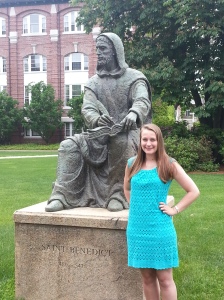
For some time, One Thing after Another knew that History-International Relations double-major Aidan Pierce ’22 spent his summers working as a park ranger in Boston harbor. It was only recently, however, after Pierce had spent a third summer at this job, that this blog decided to ask him about how his work experiences and his History major intersected.
Q; Why did you choose to attend Saint Anselm College?
A: It’s really an unremarkable story. I had applied to many small, liberal arts schools in New England, and unlike other schools, Saint Anselm College gave me the aid I needed. What’s remarkable is what followed. After my frustrating college application process, it took me some time to feel like Saint A’s was for me. The relationships and friendships I have since built fostered a profound sense of home; it is not where you imagine or wish yourself to be, it is where you are accepted and welcomed as a member of a community. The History Department has served as this home, and I’m delighted with the friendships I’ve made among the faculty and majors there.
Q: You study History and International Relations. What are some of your favorite academic areas to dive into? Do you find that your two majors complement one another?
A: After college, I plan to specialize in cultural diplomacy in either practice or academia, which falls a bit more under my International Relations major but is ultimately informed and guided by my passion for history. I deeply enjoy learning about the progress of international relations over time and developing an understanding of how states interact. As a practitioner of diplomacy, one wouldn’t have a complete toolkit without some understanding of how people have learned to come together and settle differences peacefully. Cultural diplomacy specifically focuses on how culture (the arts, educational exchange, anthropological heritage, etc.) can be a tool to deepen ties between nations and peoples. I don’t know how I could pursue my hopes and aspirations without my History classes.
Q: Your work this summer included a job at the Boston Harbor Islands State Park. How long have you been working there? What would you say piqued your interest to seek out this job in the first place?
A: I had the good luck of having an older sibling who worked as a laborer and landscaper on the island before I applied to be a Park Ranger. His stories of the idyllic scenery and boat rides to work were too much to resist, and three years ago, I began working with the Massachusetts Department of Conservation and Recreation. I was excited to work outside at a National Park, and I’ve deeply enjoyed connecting with a great number of people from all over the world. And the thought of wearing a hat like Smokey the Bear was the clincher.
Q: Could you tell us a little about your specific position? What would a typical day look like during your summer job?
A: I am a Park Ranger which entails certain tasks and responsibilities, like rule enforcement, visitor safety, and education. However, being on an island out in the harbor means the job is unique compared to those at many other state or national parks. I work mostly on Georges Island in Boston Harbor, which is the site of Fort Warren, New England’s most historically rich Civil War site. It takes about twenty-five minutes by boat to get from Hingham to Georges, and from there I raise the colors, update weather information on our boards, and unlock the visitor’s center. A ferry brings visitors from Boston, and this boat can have anywhere from a couple to several hundred people on it. Part of my job is conducting boat traffic between these ferries, the commuter boat, and private boaters using a radio. Most days, I also give a tour of the fort, which was built between the 1830’s and 50’s, before it was used as a coastal artillery base and prison for political and military Confederate prisoners of war. During these tours, I tell stories about personal experiences from the fort and aim to interpret the historical artifacts to all of my diverse visitors. I also developed a specific program this past summer where my walking tour was based on women’s contributions to the story of Fort Warren. I’ve also had some opportunities to engage in some light historical preservation. There are many structures on the islands that were built well over a century ago, and a combination of ocean weather and vandalism necessitates a maintenance that won’t interfere with the historic integrity of the artifact.
Q: Would you say that your academic experience at Saint Anselm has helped you grow in your role working in public history?
A: Certainly. Civil War history is not my specialization, but as a Saint Anselm student of history, I’ve been taught how to find many narratives within a single story which helps me engage at a deeper level with the history I’m surrounded by. Writing papers for my classes has also developed my ability to take complex historical events and distill them into their major elements, as much as it’s possible. This is necessary at work when I’m going through our archives to develop programs for our visitors that they might enjoy and learn from.
Q: Do you hope to continue the public history line of work after graduation, or will your career aspirations take you in a different direction?
A: Public history likely won’t be my line of work, but it will always inform my future career pursuits as well as my present aspirations. I’ve been grateful for my time working for the Commonwealth, and I’ve gained a great many skills, relationships, and memories from my three years. As I hope to be a diplomat, a deeper understanding and appreciation of American history will never be a waste of time as I do what I can to be a good ambassador for our country.











